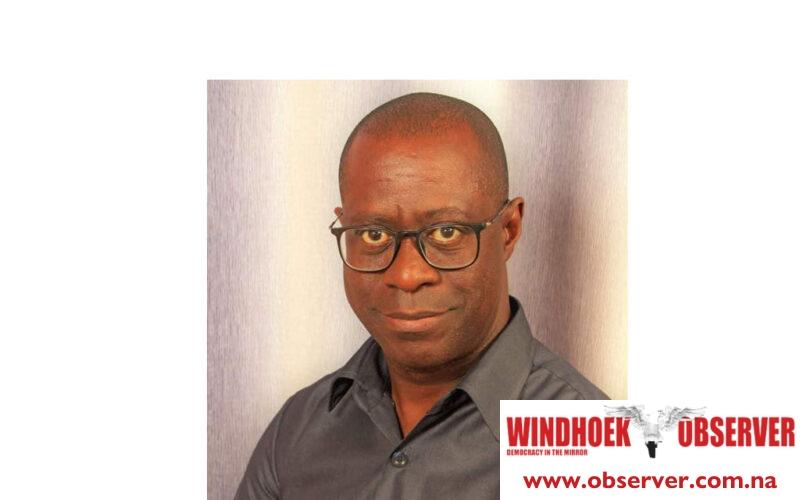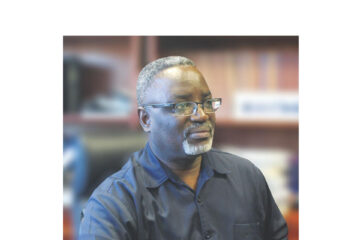(A chapter review of the Ph.D Thesis by Dr. Hage Gottfried Geingob)
By: Stanley Nick Katzao
“Leaders are bridges that connect people to the future”
We are looking at a scholarly project representing an academic endeavour at providing an intellectual discourse that connects the process of state formation to the democratization imperative.
Overall, Dr. Geingob’s study sets out to do four things:
It examines significant events in the process of state formation in Namibia;
It identifies and dissects the different actors who played a major role in shaping the Namibian state that evolved;
It examines how Namibians sought to build a united and peaceful society; and
It carries out an assessment of Namibia’s democratic performance since the attainment of independence.
The work stretches over seven chapters. The author economically compresses a political history covering one-hundred-and-twenty (120) years into only two-hundred-and-eighty (280) pages. My task tonight is even more daunting in that I have to further reduce this to six (6) pages.
CHAPTER ONE outlines the research questions, explains the research methodology and sketches the essence and significance of the study. Amongst others, the questions addressed are:
How the different players did historically influence the events that shaped the state that eventually emerged? How did Namibians respond in seeking their own statehood? And since independence what have the Namibians done to construct a modern state?
A ‘case study approach’ was adopted as the methodological choice for its adaptive character as it can accommodate qualitative and quantitative perspectives, techniques and standards. It is, therefore, particularly responsive to questions of why the European powers had such vested interest in the fate of Namibia and its people, and how they managed to influence and impact the events surrounding state formation in Namibia.
CHAPTER TWO provides a synoptic overview of the role and impact of external political forces on Namibia’s history. Namibia had been affected severally and variously by different foreign interests. It had known German influence under two disguises, first as a German Protectorate and, thereafter, as a Crown Colony.
It became a part of the “spoils of war” that came under the control of the Allied Forces after the Great European War in 1919.
The international context was dominated by the Cold War and the Namibian issue was greedily and opportunistically injected into the East-West Conflict equation. The interplay of the impact of actions and reactions of the various forces on the Namibian question given its high international profile is analyzed in this chapter.
CHAPTER THREE deals with the implementation of the United Nations Independence Plan for Namibia as entailed in the United Nations Security Council Resolution 435 (1978).
This chapter provides an insight into the dynamic and manoeuvring of the various players in the Namibian dispute.
It covers internal developments commencing with the Odendaal Plan of 1968, the Turnhalle Conference convened in 1975 and the appointment of various Administrator-Generals as Colonial Governors from 1977 -1989.
The role of the African continent as represented by the OAU and the Frontline States is highlighted.
The intricate web of international players both in the capitalist West and the then Eastern-bloc respectively led by the USA and the then USSR is dissected and their motives exposed.
The Linkage Issue – the implementation of Resolution 435 and the withdrawal of Cuban troops from Angola – is captured. The author also chronicles the events at Cuito Canavale around February/March 1988, which culminated into what came to be known as the Angola-Namibia Accords entered into by Angola, Cuba and South Africa on 22 December 1988 and subsequently endorsed by the UN Security Council on 19 January 1989.
He exposes the USA’s diplomatic initiatives under the aegis of Dr Chester Crocker to opportunistically propose the “positive sum” formula to the disputing parties with regard to expediting the implementation of the independence plan. The “positive sum” formula simply meant – something for everyone!
CHAPTER FOUR deals with the process of drafting the constitution that was to launch the Republic of Namibia. To provide the intellectual context the chapter kicks off by briefly delving into the genesis and evolution of constitutionalism as a discipline in the milieu of the study of politics. Constitutionalism is in essence a pursuit in limiting the power of the state.
The author reminds us that it is noteworthy that Namibia could justifiably claim to be the first African country to draft its own constitution through a Constituent Assembly. In this respect there was no precedent to draw from and Namibians had to think on their feet and improvise as they were going along how best to do it.
The Constituent Assembly met for the first time on 21 November 1989. The first order of business was the election of the Chairman. Dr. Hage Geingob was elected Chairman and, therefore, the mammoth task of steering the ship onto what was for all intents and purposes an untamed sea and to keep it afloat with an even keel, fell on his broad shoulders as the facilitator of the proceedings. Confidence-building and even-handedness were to be essential building blocks for the successful facilitation of the process. And I quote Dr. Geingob’s opening remarks as follows:
“The people of Namibia have given us a mandate to hammer out and adopt in a spirit of compromise, a spirit of give and take, a Constitution, which will launch our country and people into Nationhood. This is a trust we dare not betray..!”
Issues that accounted for heated, demanding and potentially explosive altercations were:
The role of the Presidency – Executive or Ceremonial Head of State?
Tenure of the President – will there be a limit to the number of times one would be eligible for the Presidential post?
Powers of the President – would there be a diffusion of Executive power?
Legislature – accountability, checks and balances – single chamber or bicameral?
Bill of Rights
Electoral System and the
Procedure for Amending the Constitution
To the consternation of many a prophet of doom the Constitution Drafting Project was magnanimously completed in an 80 days record time.
CHAPTER FIVE is dedicated to the process of state formation with specific reference to putting in place the Executive arm of government and its attendant institutions, systems and processes.
Like any academic worth a dime, the author avoids the short-cut route of jumping straight into discussing the processes of establishing the institutional infrastructure and the staffing thereof. Rather, the chapter grapples with the philosophical underpinnings of state formation in human society.
He also engages and interrogates the dynamics of the peculiarity of the taxonomy of the colonial state, and unobtrusively confronts the distinctiveness of the post-colonial state in Africa. This is a necessary backcloth for a comprehensible explanation and grasp of the nature of the state that emerged in post-colonial Namibia.
The specially-Namibian Republic we have today exhibiting characteristic features of both an organic state and strong underpinnings of an individualistic laisez fair state – are explicable in terms of the dynamic of 19th century colonization and 21st century globalization. Namibia is a state whose conceptual framework and architecture were done in the 19th century and the actual construction thereof rounded off in the 21st century.
The author raises concern over the procedural, security and diplomatic challenges the act of transferring power to the new government presents.
Procedurally, the South African occupation having been declared illegal – what would be the role of the South African government in handing over the instruments of power?
Security, considerations revolved around the issue of the propensity of the racist South African regime to sabotage the transition project as Namibia represented its last remaining buffer state.
Diplomatically, what would be the status and role of the Frontline States during the transition period with specific regard to the transfer of the instruments of state power?
Dr Geingob unveils in a very enlightening and humorous scholarly manner the intrigues involved in addressing and resolving the above-mentioned paradoxes.
On establishing the executive arm of Government, the author cites Proclamation 3, 1990, which amended the existing Public Service Act and abolished departments and created new offices, ministries and agencies in line with the provisions of the constitution. The process of regrouping the administrative departments and collapsing the structures of the various ethnic administrations into new Offices/Ministries/Agencies began.
A number of public service reform initiatives were embarked upon. That is, WASCOM Project (1995); Rationalization of the Civil Service Report; The 1994 Decision to deregulate, commercialize and even privatize some non-core functions. Budgetary processes had been reviewed to streamline operations and mainstream some priority programmes and projects.
CHAPTER SIX continues the discussion on the process of state formation in Namibia started in the preceding chapter, and brings into focus the strengthening of state institutions and other relevant institutions in civil society. This section revisits the basic tenets of social theory discourse as it pertains to the following themes: relationship between state and society; citizens’ expectations from the state; role of the state in the economy; and democracy and cultural relativity.
It is submitted that government is expected to be responsible for meeting basic needs of the citizens. And democracy is not valueless.
The Namibian state faces a number of challenges, among others, reconciliation; affirmative action; media freedom; decentralization; corruption and general threats to democracy.
Dr Geingob frontally squares up to the question of national reconciliation and the related attendant issue of a Truth and Reconciliation Commission debacle. A plausible and logically coherent argument is put forward with regard to the inappropriateness of a South African like Truth and Reconciliation Commission in Namibia. Three reasons are advanced:
Blanket Amnesty was an integral part of the settlement agreement, and a Truth and Reconciliation Commission undertaking would represent a negation of this entrenched pillar of the settlement agreement.
The alleged culprits or wrongdoers are gone – back to South Africa and far and are unlikely to offer cooperation.
Alleged wrongdoers would only be brought from one side – the SWAPO Party side, and this is inherently unfair.
State and civil society institutions were strengthened through the following means:
Affirmative Action project was rolled out;
An Anti-Corruption Commission has been set up;
Freedom of speech and expression, and by extension, freedom of the media, is guaranteed;
Government has embarked on a decentralization project.
Dr Geingob signs off his dissertation of state formation and the promotion of democracy and good governance in Namibia with a simulation of a democratic audit.
He employs the Swedish Democratic Audit Model to make an assessment of the performance of the democratization process in Namibia. This model looks at the following Key Result Areas:
Popular government
Constitutional government
Effective government
The study concludes that the national agenda is controlled by popular considerations. There is generally a relatively enlightened understanding of the challenges of democratic governance. There is an effective citizenry participation in the political processes. There is general citizen tolerance and decision-making is quite sensitive to the notion of equality including gender sensitivity.
On balance, it is submitted that, if the results shown by the foregoing democratic audit is anything to go by, then Namibia has performed spectacularly well during the first and half decades of its sovereign existence with regard to both state formation and democratization.
In terms of good governance and democracy the study is positive that the Africa Peer Review Mechanism (APRM) could be a useful tool and should be embraced.
In conclusion the study calls for the establishment of a Foundation dedicated to assessing the progression of democracy from year to year to point out strengths and shortcomings.
I submit it is only fair and befitting to sign off my intervention with a quotation from Dr. Hage Geingob’s thesis:
“The problem is not African States’ exogenous origins, but how governments transform societies to emphasize STATEHOOD and give expression to the aspirations of a heterogeneous society …” [Ibid. page 191]




